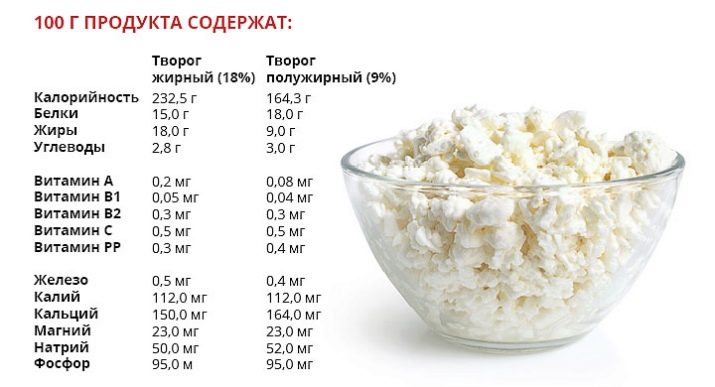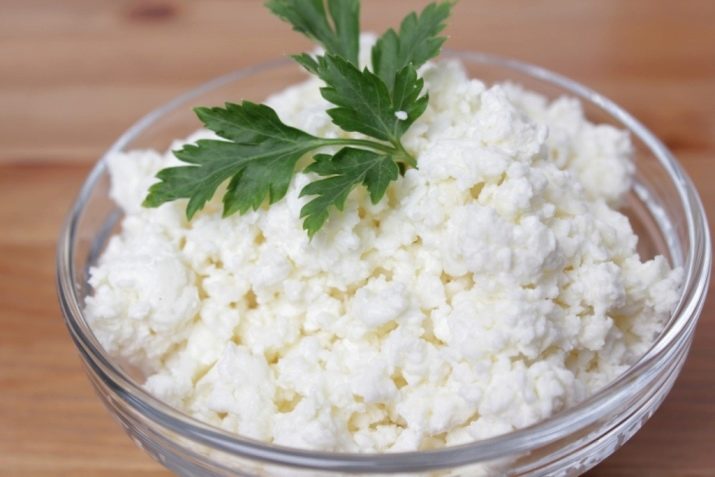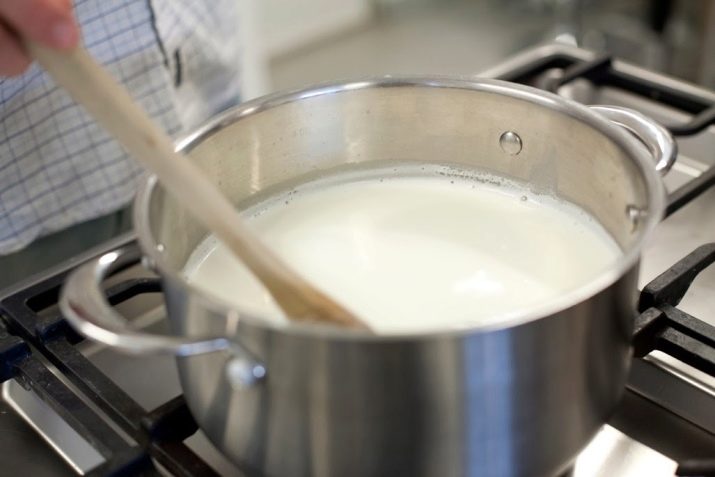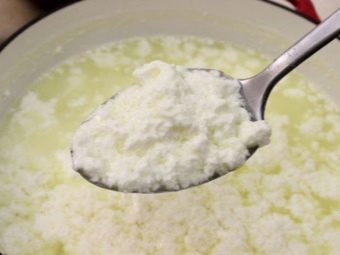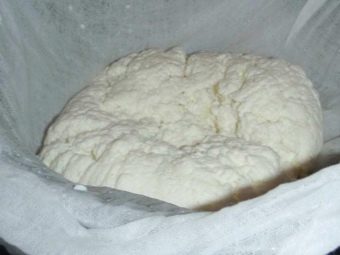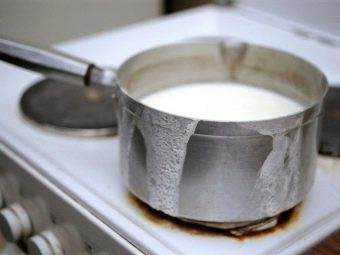Grain curd: the benefits and harm, cooking methods
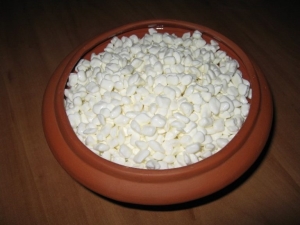
It's no secret that dairy products are considered among the most necessary for the body. This category includes granulated cottage cheese - a mixture of skimmed milk grain and cream, which has a slightly salty taste. Next, we consider its main characteristics, note the advantages and disadvantages, and also offer recipes for its self-cooking at home.
Composition and calorie
The composition of this cottage cheese includes:
- a protein containing amino acids, more commonly known as methionine, lysine and choline;
- fats, carbohydrates, Na, K, cholesterol (the last three - in small doses), Ca, Fe, Mg, as well as vitamins of groups A, B6, B12, C, and D.
If we talk about calorie and fat content, then it should be noted that cottage cheese is recognized as one of the most low-fat dairy products. This figure reaches a maximum of 0.9-1%.
Caloric content - up to 155 calories per 100 grams, which is one of the lowest among dairy products.
What is different from the usual?
You should not consider ordinary and granulated cottage cheese the same, because they have enough differences.
- Taste. Grained cottage cheese has a salty taste due to cream and salt, which are its main ingredients. Without them, the curd will be the most common.
- Consistency. Granulated curd is softer and more delicate in consistency. Again, thanks to the cream.
- Calorie. In a typical bold product, it is about 169 kilocalories per 100 g. The caloric content of the very fatty granulated curd, as already mentioned above, is within 155 kilocalories per 100 g.
- Useful material. Grained cottage cheese includes much more minerals, when compared with the usual. In the granulated product are almost all the elements necessary for the growth of the body and maintain its health. Moreover, nine tablespoons of granulated cottage cheese is enough to get a daily rate of casein and calcium.
What is useful?
The benefits of granulated curd, as well as all animal products in general, can be talked about forever. The main advantages of the use of granulated cottage cheese are hidden in its composition.
- Amino acids contained in any granulated cottage cheese - its undoubted advantage over other products. Lysine helps to strengthen the muscles of the heart, which affects the entire circulatory system of the body entirely. Choline supports the nerves, and methionine releases excess cholesterol.
- Cottage cheese as a whole is a valuable source of calcium, however, in the grain product its quantity is higher than in the usual one. Therefore, we can understand why it is so useful for children, especially in adolescence, when the bones begin to grow sharply. There is no doubt its usefulness for the elderly, since calcium additionally strengthens bones.
- Casein protein will be useful for athletes, bodybuilders and people suffering from obesity. First of all, due to the low fat content and calorie content. Therefore, this cottage cheese is included in the diet of many diets (except salt-free).
- Easy digestibility allows even small children to be added to the cottage cheese.
- Neutral acidity - another plus granulated cottage cheese. This cottage cheese is allowed for people with diseases of the gastrointestinal tract.
Doctors recommend eating granulated curd after operations and during rehabilitation.
Contraindications and harm
In general, there are no specific contraindications for eating this type of cottage cheese. The only exception is people with intolerance to certain substances that are contained in this cottage cheese. In other cases, this cottage cheese is not contraindicated.
I would like to note that there are no side effects from the use of this cottage cheese, therefore it does not bring any harm.
But doctors and nutritionists do not recommend abusing granulated cottage cheese. Should be content with its moderate use.
How to make at home?
Every housewife knows that homemade is the best and tasty.Therefore, we have prepared for you a few recipes for making home-made granulated cottage cheese.
Please note that milk in all cases must be either skimmed or with a minimum percentage of fat.
First way
Ingredients Required:
- milk (4 liters);
- boiled cream;
- Meito enzyme.
Instructions for cooking.
- Pour into a saucepan 4 liters of milk and warm it to 37 degrees.
- Take 1/20 part of a bag of enzyme Meito and dilute it in 50 ml of warmed water.
- As soon as the milk reaches the desired temperature, pour a solution consisting of water and Meito enzyme into it.
- Mix well, cover with something and put in a warm place. The time of thickening of the solution should be approximately 30-40 minutes.
- At the same time, prepare 3 containers with water poured into them: one - 18 degrees, the second - 10 degrees, the third - ice.
- After the mass thickens, cut it into cubes.
- Put the pan with the cubes of cottage cheese on a small fire, do not forget to stir and wait for the selection of whey.
- Using gauze, drain two thirds of the serum formed.
- Pour 18-degree water into the mass and mix for about three minutes. Then strain the mixture through a sieve and return the mass back.
- Pour the pre-prepared 10-degree water and stir for about five minutes. Strain and return the mass back.
- Pour over ice water and stir for about twenty minutes. Strain.
- Remove excess water and leave the cottage cheese in this form for several hours.
- Transfer the finished product in a bowl, add salt and pour it with boiled cream.
Second way
Ingredients necessary for us:
- milk;
- fresh cream;
- calcium chloride;
- salt to taste
Instructions for cooking.
- Boil the milk to a temperature of about forty to fifty degrees.
- Pour calcium chloride into milk. Do not forget to constantly stir the solution, because the future curd begins to thicken from the very first minutes.
- As soon as the curd seeds appear, remove from the heat and put the pot in a container with water. Do not forget to stir.
- The cooled mass must be filtered through a sieve, and then squeeze it to remove the remaining serum.
- Add to the resulting cottage cheese pre-prepared salt, low-fat cream, then mix well.
Third way
Ingredients Required:
- milk;
- salt;
- cream;
- lemon juice or acid.
Recipe:
- pour milk into a prepared pan, warm it, but it does not need to bring to a boil;
- add lemon juice or acid and stir for about two to three minutes;
- remove the pan from the heat, cover with a cloth and place in a warm place for one hour;
- strain the finished product through a sieve;
- rinse with cold water and gently squeeze so that the mass is completely dry;
- add pre-prepared salt, cream, mix and serve.
Fourth way
Ingredients necessary for us:
- pasteurized milk (3.5 liters);
- table vinegar (3/4 cup);
- cream;
- salt (0.5 tsp).
Cooking Instructions:
- put the pot of milk on a low fire;
- when the milk is ready to boil (but not boiling), add vinegar and stir for two to three minutes;
- turn off the heat and leave for thirty minutes;
- chilled curd mass strain through cheesecloth or sieve;
- after five minutes (the whey should be completely drained), rinse the curd mass with water and leave to drain for a few minutes;
- fill the product with pre-prepared salt and cream.
We offer several useful tips on cooking home-made granulated curds.
- Milk. Since this type of cottage cheese is low-calorie and low-fat, it will be much better to use milk with the smallest percentage of fat. And even better - pasteurized skim.
- The better to sour milk? Calcium chloride is most often used to obtain calcined granulated curd. To get the usual granulated cottage cheese is often used in the course of lemon juice (you can take acid), vinegar or special enzymes.
- Excessive addition of calcium chloride will make the product too bitter. The ideal ratio of chloride and milk is one and a half spoons per liter.
Filing options
Most often granulated cottage cheese is served at breakfast, adding to it vegetables, fruits, cream sauces, raisins, nuts. Since granulated cottage cheese should have a salty taste, you cannot combine it with sweets (jam, syrups).
Granular cottage cheese is appropriate in some salads and is used in the preparation of cheesecakes and casseroles. Grained cottage cheese is not bad in combination with pancakes, pita breads, Turkish flat cakes - any savory pastries. A good option is sandwiches with granulated cottage cheese and green onions.
Houses in a slow cooker make such a cheesecake with jam. Its production is not very complicated. A classic recipe is used and jam is added.
Learn more about how to cook cottage cheese, you will learn from the following video.

